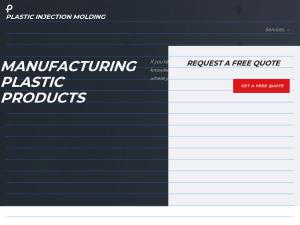Pegasus Injection Molding
Pegasus Injection Molding
8 Clay Street
Dayton, OH 45402
8 Clay Street
Dayton, OH 45402
Categories: , Contractors
plastic injection molds
How does Plastic Injection Molding work?
Injection molding, a manufacturing process that produces parts by injecting molten plastic into a mold, is the answer for many company’s products. After all, plastic injection mold products are all around us. Lawn chairs, keyboards, legos…the list goes on! Injection molding is widely used for manufacturing of a variety of parts - both the smallest of components and the entire body panels of cars.
Plastic material is fed into a heated barrel in the manufacturing process and is mixed using a helical shaped screw and injected into a mold cavity where it cools and hardens to the shape of the mold design. Why do our customers choose our injection molding company? The price per unit during injection molding manufacturing is extremely low and continues to decrease as more parts are produced. Traditional manufacturing processes like CNC machining cut away parts of an existing plastic block or sheet, resulting in waste and scraps. Injection molding, on the other hand, creates nearly no waste with the only scraps being the sprue, the runners and the occasional molten plastic overflow from the part’s cavity.
A sprue is the vertical passage or large diameter passage through which the molten plastic is put into a mold. Once the sprue cools and solidifies, it is removed from the part. A runner is a smaller diameter channel cut into the mold that allows the molten plastic to flow from the nozzle to the cavity, and is typically used when casting multiple parts at once.
Our customers choose injection molding because it is very repeatable and the first part produced will be identical to the last part produced. Expect consistency no matter the quantity of parts created.
Keywords: plastic injection molds, Over-molding, insert molds, Family molds, Production molds, plastic part design, Injection mold prototypes, plastic materials, Polypropylene, polyethylene, abs plastic, plastic injection molding, injection molding near me
How does Plastic Injection Molding work?
Injection molding, a manufacturing process that produces parts by injecting molten plastic into a mold, is the answer for many company’s products. After all, plastic injection mold products are all around us. Lawn chairs, keyboards, legos…the list goes on! Injection molding is widely used for manufacturing of a variety of parts - both the smallest of components and the entire body panels of cars.
Plastic material is fed into a heated barrel in the manufacturing process and is mixed using a helical shaped screw and injected into a mold cavity where it cools and hardens to the shape of the mold design. Why do our customers choose our injection molding company? The price per unit during injection molding manufacturing is extremely low and continues to decrease as more parts are produced. Traditional manufacturing processes like CNC machining cut away parts of an existing plastic block or sheet, resulting in waste and scraps. Injection molding, on the other hand, creates nearly no waste with the only scraps being the sprue, the runners and the occasional molten plastic overflow from the part’s cavity.
A sprue is the vertical passage or large diameter passage through which the molten plastic is put into a mold. Once the sprue cools and solidifies, it is removed from the part. A runner is a smaller diameter channel cut into the mold that allows the molten plastic to flow from the nozzle to the cavity, and is typically used when casting multiple parts at once.
Our customers choose injection molding because it is very repeatable and the first part produced will be identical to the last part produced. Expect consistency no matter the quantity of parts created.
Keywords: plastic injection molds, Over-molding, insert molds, Family molds, Production molds, plastic part design, Injection mold prototypes, plastic materials, Polypropylene, polyethylene, abs plastic, plastic injection molding, injection molding near me
Customer Reviews for Pegasus Injection Molding
Be the first to review Pegasus Injection Molding - Use the thumbs to get started!
Pegasus Injection Molding has not yet completed their interview.
- ©2025 DaytonBusinessList.com
- Privacy Policy
- FAQ
- Contact
This site has been visited 3,091 times

